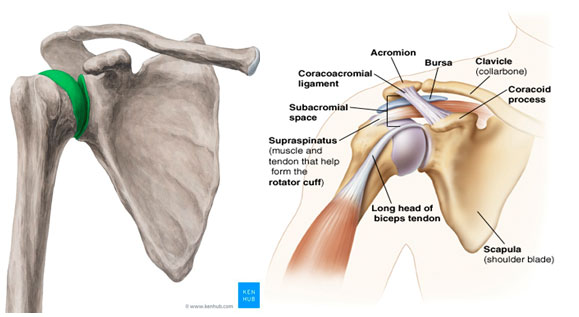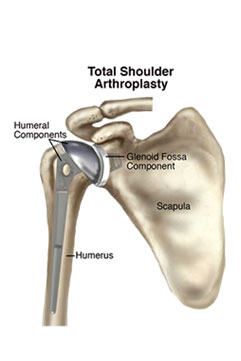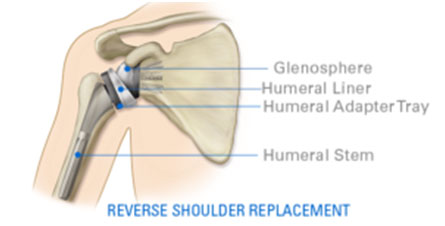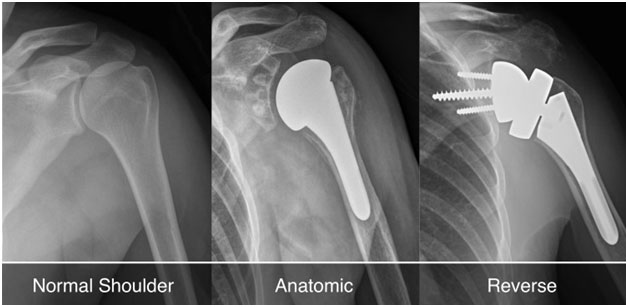Who needs from shoulder replacement?
Many cases of shoulder pain can be solved with minimally invasive treatments such as anti-inflammatory injections, routine physically therapy and arthroscopic surgeries. However, patients who experience chronic pain because of degenerative processes/conditions, such as osteoarthritis or rheumatoid arthritis, typically require more intensive treatment, up to and including shoulder replacement.
Who benefits from shoulder replacement?
The patients who benefit the most from shoulder replacement are those who currently experience chronic pain due to degeneration in their shoulder joint or older patients with slow deterioration in their joint because it has simply worn out.
What does shoulder replacement recovery look like?
Shoulder replacement surgeries typically fall under two major categories:
- Total shoulder replacement
- Reverse shoulder replacement
Both modes of treatment involve completely replacing the joint with artificial parts to improve the structure and mobility of the patient’s shoulder. In addition, the preparation for your surgery will be identical regardless of what procedure your physician chooses to do.
A normal shoulder joint is composed of a ball (humeral head) and a socket (glenoid)

Total Shoulder Replacement (Anatomic)
Total shoulder replacement typically involves an incision through the front, after which the surgeon will shave some of the bone on either side of the joint and replace it with a metal stem (humeral) and a dish-shaped glenoid, or plastic-like piece. In addition to decreasing the overall level of pain you may experience, this procedure can help increase your shoulder function& significantly reduce pain.
Function after a total shoulder replacement is typically 90%+ in most cases.
An Anatomic Shoulder Replacement places the “ball” where the head is and a “socket” on the glenoid side

Reverse Shoulder Replacement
Reverse shoulder replacement differs from traditional replacement in the type of materials used, as well as the recovery time. Due to advances in surgical techniques, reverse shoulder replacement is an increasingly common procedure.
A reverse replacement is typically used in the case of severe fractures, irreparable rotator cuff tears or failed total shoulder replacements
In this case we reverse the components and place the “ball” on the socket side (glenoid side) and a socket on the “ball side’(humeral head side)…sounds backwards
The main reason for this technique is because it does not need a rotator cuff to function. In fact, if you place a regular total shoulder in a patient with a non-functional rotator cuff it will loosen and fail!!

How good are reverses? Well depends on the indication. A reverse shoulder replacement for a chronic rotator cuff tear yields approximately 75-85% good results depending on the study and is better at relieving pain than improving function. When doing a reverse replacement for severe fractures the success rate declines.

Recovering from a Shoulder Replacement Surgery
Recovery from shoulder replacement surgery is a long process which depends on a variety of factors, including age, general health and post-surgery behavior. Younger, healthier patients are sometimes sent home the same day of surgery or may spend one night in the hospital for observation. Patients will typically require a sling for 2 to 3 weeks and begin physical therapy shortly after that. Basic functional movement can resume within several weeks, but it will generally take 3 to 4 months — and sometimes as long as 6 months — for patients to continue improving. The entire process from surgery to full, normal routine will often take a full year.
Am I a candidate for shoulder replacement?
You may be a candidate for shoulder replacement if your chronic pain has progressed to the point where it interferes with activities in your daily life. If you are unable to sleep at night or go outside to do the things you enjoy, it is probably time to have your shoulder replaced. If pain does not respond to anti-inflammatory medications or injections, or X-ray findings suggest deterioration due to chronic conditions, your physician may recommend shoulder replacement.
